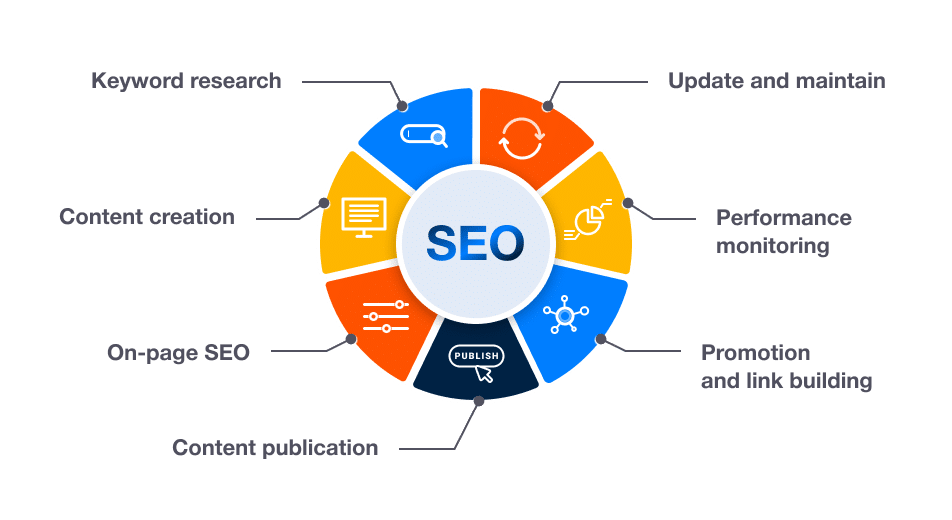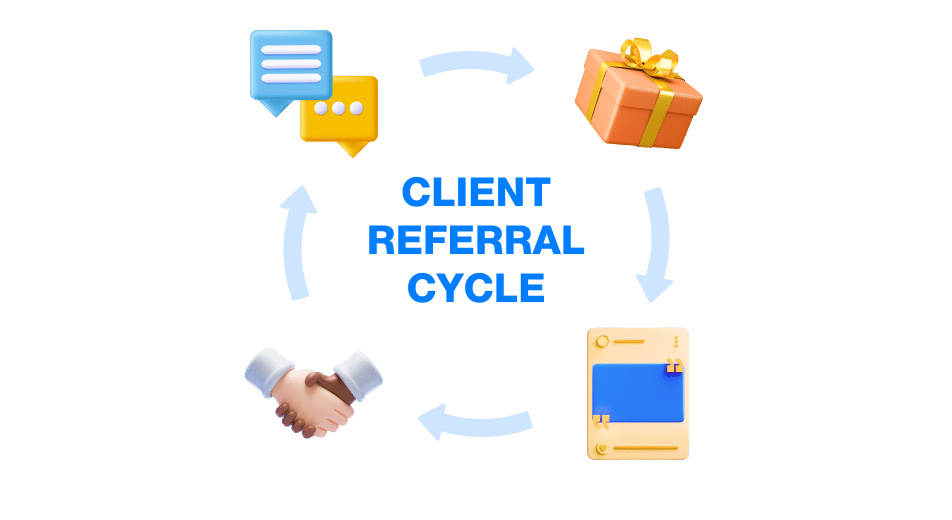Whether you’re a seasoned insurance agent or just starting, you’ll need to know how to get new clients in today’s modern business environment. With fierce competition in the industry and endless ways to market yourself, it can be tough to figure out which path to take.
To help you grow your business, we have five proven marketing strategies to help you attract new clients and grow your insurance business faster than ever before.
In this guide, we’ll also provide recommendations for which strategies would best suit your personality, strengths, and goals.
If you see yourself fitting into one of these strategies, try it out and start getting clients for your insurance business.
Ready? Let’s dive in!
Strategy 1: Content marketing
If you’re a creative type who loves writing posts, filming videos, or connecting online, then content marketing might be a good fit for your insurance business.
Content marketing is a strategy focused on creating and sharing valuable, relevant, and consistent content to attract and engage a specific audience.
This content can take many forms, such as:
- Articles
- Videos
- Infographics
- Podcasts
- Blog posts
- E-books
- Webinars
- Case studies
- White papers
- Email newsletters
The good news? You don’t have to do every type of content out there. If you’re good at writing, focus on that. If you’re more confident in speaking and filming yourself, use your strengths for video production.
Let’s dive deeper into a few of the content formats we recommend for insurance agents:
Grow your social media following
The good thing about social media marketing is it’s simple to get started. If you don’t have one already, creating an account is straightforward. And publishing content takes only a few clicks.
LinkedIn is the primary social media platform where business leaders connect. However, Instagram, Facebook, or even TikTok can be great for presenting the value of your business and educating your target audience. YouTube is also a great place to put your videos, especially because, once they are posted, their value can grow over time as more people find them.
Creating valuable content is non-negotiable when choosing this route. It establishes authority and captures readers’ attention by cutting through the noise.
Chat with thought leaders on a podcast
Podcasting has been growing in popularity over the last few years. It allows you to share your thoughts, ideas, and expertise without needing to show your face.
If you prefer conversation, dialogue, and verbal communication, starting a podcast might be the perfect content format for you.
To get started you can sign up on the most popular streaming and podcast hosting platforms like Spotify, Apple Podcast, and Podbean.
Host webinars with industry experts
If you possess excellent interpersonal skills and have a knack for answering questions on-the-fly in real time, organizing live webinars could potentially boost your conversion rates.
Webinars offer a unique opportunity to connect with your audience and engage with them on a personal level. By conducting live webinars, you can establish a sense of trust and authority among your target audience, leading to increased brand loyalty and better customer retention.
Make sure to choose a subject that is:
- Compelling to your target audience and
- Allows you to provide serious value
Deliver value to your email list
Your email list is the only audience you have exclusive control over. Everything else is just “borrowed” following.
The way most successful email lists are built is by offering people something valuable, such as an ebook in exchange for their email address and personal details. This valuable offer is called a lead magnet.
You can create detailed guides or ebooks on specific insurance topics and offer them for free on your website in exchange for users’ contact information. Of course, this would need to be done in addition to somehow getting people to the website. That can be done through SEO, social media posting, podcasting, and another way is to…
Strategy 2: Digital advertising
If you’re looking for quick results to promote your business, you may want to consider paying social platforms like LinkedIn, Meta, and Google to advertise your services.
Digital advertising allows you to use targeting, analytics, and real-time optimization to enhance the effectiveness of your campaigns and accurately measure their success.
By advertising online, you can take advantage of algorithms that track users’ behavior, engagement, and recent actions, which increase your chances of getting your business in front of interested, actively looking for options, or “ready-to-buy” people.
Getting started with digital ads can vary from platform to platform. But here’s a basic overview of the steps:
Also, be aware that this strategy can be expensive to get started, and it can take time to optimize the ads until they really begin to bring in good leads.
But if done correctly, using paid ads has one of the quickest returns on investment when it comes to your marketing efforts. In order to do it correctly, though, you usually need other content to support it, such as a good video or landing page that convinces users to consider your services.
It’s also important to note that once you have advertisements set up, you can continue to engage people who click through to your website or landing page by setting up a way to keep track of them and remarket to them. Ask your programmer to set this up for you depending on the platform you are using to advertise. For example, you might need to add a Facebook Pixel, Google Analytics tracking code, Google Ads conversion tracking tag, or a LinkedIn Insight Tag.
Also, be sure you have Google Analytics set up to keep track of and analyze your data over time to gauge performance.
Print/TV advertising
Although digital marketing is where lots of business happens nowadays, there is still plenty of opportunity to be found in the old-fashioned advertising channels. Did you know that TV ads on a local channel can cost just a few dollars per showing (depending on location, timing, etc.)?
The main question to ask yourself is, “where are your ideal clients and where do they spend their time?” And by “clients” I mean the decision makers in potential client companies. For example, if they’re likely to be reading your local newspaper, consider taking out a large ad there explaining things they should be considering when looking for an insurance agent.
Another option is simply to pay your local periodical to run an article you’ve written. Or, even better, if you’re able to write a fantastic article, they may even print it for free. Be sure to mention your services and make it possible for them to contact you.
Strategy 3: Search Engine Optimization (SEO)

Do you want to reach potential customers online without spending a ton of money on ads? If so, focusing on SEO might be a great option. But it takes time and patience.
SEO combines the advantages of both social media marketing and paid advertising.
Social media marketing might be free, but it’s tough to compete for users’ attention. And you may not be reaching those actively searching for your service.
On the flip side, paid advertising can be great for reaching people who are actively searching for your services. But, it requires payment for ad space, which can add up fast.
With SEO, you create free content that caters to users actively searching for related keywords.
So it can be a win-win if writing blog posts is your forte! You get to provide valuable information to potential clients while also increasing your chances of attracting them to your site.
Although it combines the advantages of the previous marketing strategies, SEO is a little harder and takes longer to see the results.
But if done correctly, you can potentially have a more consistent and sustainable way of marketing your business online.
When you’re still starting out with SEO, it’s worth researching what people are actually looking for and then write about that using similar wording in your post to what people are searching for in their search engine queries (i.e. what they type into Google).
Another factor to consider is that, when you are just starting out, you will probably not be able to compete with the big players in your industry. So it’s worth answering niche queries that have less competition, which are referred to as long-tail keywords. Long-tail keywords in SEO refer to specific and usually longer phrases that users might enter into search engines when looking for detailed information.
Unlike short and more generic keywords, long-tail keywords are more targeted and have a lower search volume. However, they often have higher conversion rates because they cater to a more specific user intent.
This will make your life easier since you’re less likely to compete with the giants of your industry when you’re still starting out.
You can use keyword research tools to help you with this — or hire an SEO agency to help you. Once you’ve found these keywords, you can write your content around them.
So, if you’re looking to set up a long-term presence online, and you have the time to invest in it and are willing to write high-quality content for your website, SEO might just be the strategy for you.
Strategy 4: Client referrals
If you’ve managed to delight your insurance clients in the past but didn’t ask for client referrals, you could be missing out on a lot of potential business.

Here are three simple ways to get client referrals:
1 Just ask:
Don’t be afraid to remind your clients that you’re looking for new business. They might be too busy to think about it, but a gentle nudge could be all it takes.
2 Win-win referral programs:
Create a referral program that benefits both you and your clients. Offer incentives like add-ons or bonuses to encourage them to refer you to their friends and family.
3 Utilize your social media profile:
Share success stories and testimonials on social media. This is a great way to establish social proof and build trust with potential clients. Plus, your clients can easily share your posts with their own networks, giving you a broader reach.
Remember, positive word of mouth is a powerful marketing tool. Don’t be afraid to leverage it to grow your business.
Strategy 5: Network within your community
It’s easy to overlook the potential clients in your community.
But if you’re the type of person who thrives when talking with people, use this strength to attract potential insurance clients.
By being active and visible around your community, you can build trust and credibility with potential clients.
You might want to attend local events, fairs, or gatherings to connect with people in your community and engage in face-to-face conversations.
In addition, being involved in the community gives you insight into the specific insurance needs of the local population. This understanding could help you to tailor your services and products to meet the unique requirements of your community.
Finally, building relationships with other business owners and professionals (e.g., real estate agents, accountants, mortgage agents) within your community can lead to referrals and collaborative opportunities. So take advantage of your surroundings and use your communication skills to attract potential clients.
To sum it up
Attracting insurance clients today can be both easier and more challenging. Thanks to the internet, you can connect with more people, faster than ever before.
However, the competition is tighter, so it’s essential to pick a strategy that aligns with your strengths, personality, and goals.
Keep in mind that these strategies can only get you so far. To really outcompete your competition, you also have to deliver. Once clients come to your door through your new marketing strategies, you need genuine market differentiators to retain them long-term — like a benefits insurance and admin solution. Learn more about how Healthee helps insurance brokers stand out against their competition.











